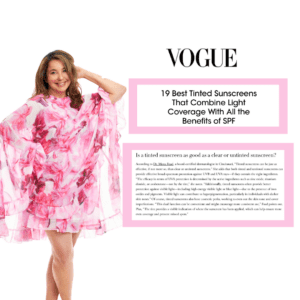Best Tinted Sunscreens With Light Coverage | Featured In Vogue
Dr. Mona Foad expands upon the insights she shared in her recent Vogue feature: 19 Best Tinted Sunscreens That Combine Light Coverage With All the Benefits of SPF

Is a tinted sunscreen as good as a untinted?
Depending on the context and usage, tinted sunscreens can be just as effective or more effective than non-tinted sunscreens. The choice between them often comes down to personal preference, specific skin care needs, and any additional benefits desired. For example, some products may have protection against visible light or more elegant cosmetic coverage.
Both tinted and untinted sunscreens can provide broad-spectrum protection against UVB and UVA rays if they contain appropriate ingredients. The active ingredients in the sunscreen determine the UVA protection and efficacy. Zinc oxide, titanium dioxide, or avobenzone are examples of active ingredients in sunscreen. The tint does not impact this UVA or UVB protection. Additionally, tinted sunscreens often provide better protection against visible light (including high-energy visible light or blue light). This is due to the presence of iron oxides and pigments in the tint. Visible light can contribute to hyperpigmentation, particularly in individuals with darker skin tones.
I like to recommend to my patients Sunforgettable® Total Protection® Face Shield Classic SPF 50 | Colorescience because this is an all oil free, mineral sunscreen which is well tolerated by all skin types. It is tinted for added protection and has EnviroScreen® Technology which protects against UV Rays, Blue (HEV) light, Infrared, and pollution. Another favorite is ISDIN’s Eryfotona Ageless Tinted Sunscreen, which is an ultralight mineral sunscreen with zinc oxide peptides and DNA Repairsomes® technology which help to repair the damage caused by the sun.
Tinted sunscreens can also even skin tone and cover imperfections. For this reason, many people like to use them as a makeup base or even a foundation substitute. This dual function can be convenient and might encourage more consistent use. The tint provides a visible indication of where the sunscreen has been applied. This can help ensure more even coverage of the product and prevent missed spots.
What should you look for in a tinted sunscreen?
When choosing a tinted sunscreen, you’ll want to ensure it meets your needs while still providing effective protection. For SPF levels, choose a sunscreen with an SPF of at least 30, which blocks about 97% of UVB rays. Another good option is good option is EltaMD UV Clear Tinted Face Sunscreen, for a light weight tinted option. Furthermore, ensure the sunscreen offers broad-spectrum protection, meaning it protects against both UVA and UVB rays. This is essential for preventing skin aging and reducing the risk of skin cancer.
Additionally, consider skin types when choosing a tinted sunscreen. For oily skin, look for non-comedogenic formulas that won’t clog pores. You can look for “oil-free” or “matte finish” on labels as this often means it is a non-comedogenic formula. One product I like to recommend to my patients with oily skin is EltaMD’s UV Physical SPF 41 Post-Procedure (Tinted). For dry skin, opt for sunscreens such as Alastin’s Hydrant PRO Mineral with hydrating ingredients such as hyaluronic acid, glycerin, or ceramides. If you have sensitive skin, choose physical or mineral sunscreens such as Colorscience’s Total Protection Face Shield (FLEX) with gentle, non-irritating ingredients that contain zinc oxide or titanium dioxide. For acne-prone skin, non-comedogenic and oil-free formulas are ideal, so look for sunscreens that also contain anti-inflammatory ingredients like niacinamide.
In addition, you’ll want to consider the shade range available for a particular product. This is important when looking to find a tint that closely matches your skin tone to ensure a natural look. Some brands offer a wide range of shades, which can be particularly beneficial for people with darker skin tones. The sunscreen should blend well into your skin without leaving streaks or an uneven finish. Testing a small amount on your jawline or neck can help determine the best match. Other factors that you may want to consider:
- Finish (matte, dewy, or natural)
- Ingredients such as antioxidants (vitamin C, vitamin E) that can provide extra protection against environmental damage
- Water-resistant formulas
